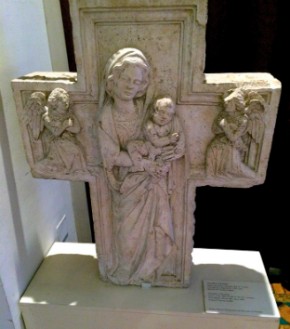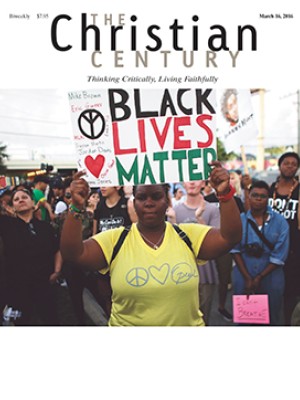Within the cross

One of the great gifts of the city of Rome is that anyone can walk into any church, free of charge, and experience art created for that very space. You can ponder Caravaggio’s painting of Jesus calling Matthew away from the tax collector’s table in the church of San Luigi dei Francesi or wedge yourself into the crowd around Michelangelo’s Pietà in St. Peter’s, knowing that for hundreds of years others have stood before these same luminous works and felt their own callings and griefs blessed and transformed. To be able to stand at the intersection between our lives and theirs, between the present moment and the past, is a gift Rome gives to the whole world.
With Good Friday coming, images of the cross catch my attention and draw me in as I walk through the city. Low-church Protestant that I am, the crosses I grew up with were usually empty, proclaiming a resurrection already accomplished. But in Rome the crosses are full of bodies. In the mosaics of the church of San Clemente, an emaciated Jesus hangs crucified, his disciples perched up and down the arms of the cross in the form of doves. In the church dedicated to his memory, St. Andrew hangs on his X-shaped cross while angels beat their wings above him, waiting to bestow his crown. Caravaggio’s decidedly angel-less depiction of the crucifixion of St. Peter draws crowds day after day in the church of Santa Maria del Popolo. Here Peter is a frightened old man who looks on helplessly as workers strain to lift his aging body nailed on an upside-down cross.
Read our latest issue or browse back issues.
All of these images offer potent Good Friday meditations. But the cross that’s struck me the most during these weeks of Lent is not drawing big crowds. It’s a small marble cross that my daughter and I came upon in a corner of the Museo Nazionale del Palazzo di Venezia. My Blue Guide calls it the least-visited museum in Rome, but it is full of amazing things—large, painted sculptures of Mary and her child, a dreamlike depiction of the vision of St. Bernard, a painting of Jesus arguing with those who want to stone a woman accused of adultery, and an altar piece with a Virgin of Mercy sheltering a crowd of people under her mantle, including a group of flagellants.
The marble cross caught my attention because it holds the Madonna and child. The 15th-century artist Andrea Guardi communicates in marble the warm tangle of their intimacy: the baby’s chubby leg slung across his mother’s arm, her hand on his knee. My daughter especially loves images of Mary holding her baby, and we admired this one for a few minutes before we realized that the image was held within a cross.
When we realized what we were looking at, it took our breath away. To see a mother and child lovingly engrossed in one another, yet held within the cross that waits for them on the horizon of their lives, was as heartrending as an image of a broken and bleeding body. Although they are surrounded on all sides by the cross, they can’t see it. Guardi eloquently reminds us that when Good Friday does arrive, Jesus will not be alone in his suffering. I read later that the cross is two-sided and that Christ hangs crucified on the other side. But the side bearing the mother and child seemed to plumb an equally profound truth: that Christ’s crucifixion happened not only to him, but to all who loved him.
On Good Friday we ponder the mystery of incarnation, the mystery of God’s vulnerability to everything that can happen to a human being. The marble cross reminded me that it’s also a day to ponder that the trajectory of Jesus’ life, from the arms of his mother to the arms of the cross, is a path upon which mothers and children are still often forced to travel. Because it’s even more dangerous for them to remain at home, mothers send their children on journeys across Central America, across the Aegean Sea, and on the many perilous refugee routes that crisscross the globe. The arms of the cross stretch wide for the children traveling on these routes. And the cross on which Jesus died is crowded with mothers and their children this Good Friday.
The works of art that have the power to draw us in also have the power to draw us out if we will let them, to send us back into the world around us with our vision transformed. As we stand, sit, or kneel before the images that move us this Good Friday, may they teach us to stand with those who are crucified with Christ. And from that solidarity, may safe routes through the world and safe homes be built so that children and caregivers can delight in each other.




